British Rail Class 159
The British Rail Class 159 is a class of British diesel multiple-unit trains of the Sprinter family, built in 1989–1992 by British Rail Engineering Limited (BREL)'s Derby Litchurch Lane Works as Class 158. Before entering traffic, the original 22 units were modified at Rosyth Dockyard to Class 159 to operate express services from London Waterloo to Salisbury and Exeter St Davids, replacing various locomotive-hauled passenger trains.
| British Rail Class 159 South Western Turbo | |
|---|---|
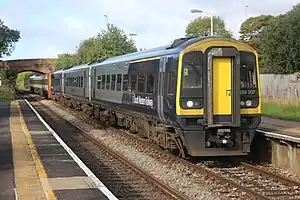 South Western Railway 159007 at Pinhoe in 2019 | |
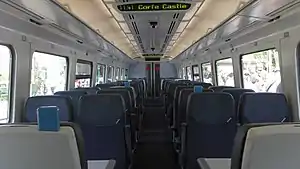 The partially refurbished interior of SWR's 159014 | |
| In service | 10th June 1993 – present [1] |
| Manufacturer | British Rail Engineering Limited Derby Litchurch Lane Works |
| Family name | Sprinter |
| Replaced | locomotive-hauled passenger trains |
| Constructed | 1989–1992 (Class 158/0, later Class 159/1) 1992–1993 (Class 159/0)[2] |
| Refurbished | 2000–2001 (Class 159/0) 2007–2008 (Class 159/0 and Class 159/1) |
| Number built | 22 trainsets (159/0) 8 trainsets (159/1) |
| Number in service | 30 trainsets |
| Formation | 3 cars per trainset[3] |
| Fleet numbers | 159001 – 159022, 159101 – 159108[3] |
| Capacity | Standard: 172[4] First: 24[4] |
| Operator(s) | South Western Railway |
| Line(s) served | West of England Main Line |
| Specifications | |
| Car body construction | Welded aluminium |
| Car length | 23.21 m (76 ft 2 in)[4] |
| Width | 2.82 m (9 ft 3 in)[4] |
| Height | 3.81 m (12 ft 6 in)[4] |
| Maximum speed | 90 mph (145 km/h)[2] |
| Weight | 37.8 t (37 long tons; 42 short tons)[2] |
| Prime mover(s) | Diesel, one per car Cummins 400 hp (298 kW) (Class 159/0)[2] Cummins 350 hp (261 kW) (Class 159/1) |
| Transmission | Voith Hydraulic T211r [2][4] 2 axles driven per car |
| Safety system(s) | AWS, TPWS[4] |
| Coupling system | BSI[5] |
| Track gauge | 1,435 mm (4 ft 8 1⁄2 in) standard gauge |
The units were originally branded by Network SouthEast as South Western Turbo.[1][6][7][8]
History and design
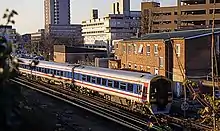
In the late 1980s, the locomotive-hauled stock on Network SouthEast's West of England route from London Waterloo to Salisbury, Yeovil Junction and Exeter St Davids was in urgent need of replacement. The British Rail Class 50 locomotives were not suited to the stop-start nature of the route, and frequently broke down.[9] Because of the long sections of single track west of Salisbury following the Beeching cuts, a single breakdown could cause chaos. Various options were considered including electrification, shortened HSTs, construction of new locomotives and stock (a passenger version of the proposed Class 48), or the proposed Class 171 (which would been part of the Networker family, an intercity version of the Class 165 – not to be confused with the later Turbostars). A study found the best options were electrification or new DMUs.[10]
With the UK economy in decline in the early 1990s, it was found that Regional Railways had over-ordered Class 158s at the same time as Network SouthEast was looking for a similar number of new diesel trains. NSE agreed to take on the surplus Class 158s.[10]
The original 22 units were built as Class 158 units, but were rebuilt by Babcock Rail in Rosyth Dockyard before entering traffic. This entailed fitting first-class accommodation and retention toilets, and various other modifications. The rebuild was required because it was not possible for Network SouthEast and the newly privatised BREL to agree terms on the variation order to NSE specification.[11]
The first unit (159004) was handed over to NSE on 6 January 1993.[1]
The 1992–1993-build units are numbered 159001-022, with individual cars numbered 52873-894 and 57873-894 for driving motor vehicles, and 58718-739 for intermediate motor vehicles. The entire class is maintained at a purpose-built depot at Salisbury.[3][2]
In 2007, eight further Class 159 units were created through the rebuilding of surplus Class 158 units displaced from TransPennine Express.[12]
All units use P4-4A and T4-4A bogies.
The units feature BSI couplers. This enables them to work in multiple with Class 158 and Class 170 units, as well as units of the same class.
Accidents and incidents
- On 4 January 2010, Class 142 diesel multiple unit 142029 collided with a train composed of two Class 159 units at Exeter St Davids. Nine people were injured.[13]
Operations
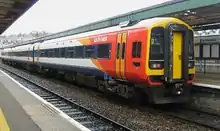
The units were dedicated to the West of England sector of Network South East, operating services between London Waterloo and Exeter; they also worked services between Salisbury and Southampton and on the Reading to Basingstoke line, replacing elderly DEMUs. They then transferred to the South West Trains shadow franchise in readiness for privatisation.
Upon the privatisation of British Rail, the West of England route passed in 1996 to the South West Trains franchise, which was won by the Stagecoach Group.[14] Starting in 2000, units were progressively refurbished and repainted from Network SouthEast's blue, red and white livery into South West Trains' express livery. Other post-privatisation modifications included clearer LED destination displays, upgraded air-conditioning, and more openable windows.
Currently, the Class 159s operate mainly from London Waterloo to Salisbury/Exeter in three- or six-coach formations, and between Salisbury and Exeter in three- or six-coach formations. Until the December 2009 timetable change,[15] some trains continued beyond Exeter to Paignton, Plymouth and Penzance; these usually operated as three-coach units, though at weekends there were some six-coach formations. These services are now operated by the Great Western Railway. The service to Bristol Temple Meads is now also in the hands of Class 159s.
Since 2006, the original Class 159 fleet of 22 has been supplemented by eight three-coach 158s (renumbered into the 159/1 series) and 11 two-coach Class 158s. The decision to standardise on 158s and 159s allowed the nine Class 170 'Turbostar' units to be transferred to other operators.[12] Eight went to First TransPennine Express, with the remaining unit going to Southern for integration into Class 171 Turbostars.
Refurbishments and conversions
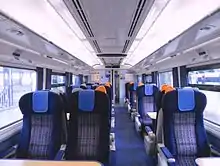
2000
South West Trains began a refurbishment programme for its 22 Class 159/0s in 2000. The seats were re-trimmed and interiors repainted. The units were repainted into SWT livery.
2008
The units received another refurbishment in 2008 at Wabtec Doncaster. CCTV and PIS (Passenger Information Systems) were installed,[16] new seating was installed in first class and at the same time the units received a modified version of the SWT express livery (with orange doors as opposed to the red doors on Class 444 units) for compliance with disabled access regulations.
C6 Overhauls
South Western Railway's Class 158 are currently in the process of being refurbished to PRM-TSI standards that allow them to run after January 1st 2020. This has also been completed on the Class 159/1 fleet and the Class 159/0 fleet will receive these standards by the 2020 deadline as well.
Class 158 conversions
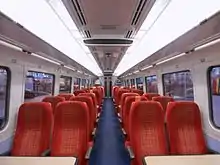
Eight of TransPennine's surplus three-coach Class 158 units have been refurbished to Class 159 standards at Wabtec Doncaster[12] and renumbered as Class 159/1.[3] The first updated units were delivered to South West Trains in November 2006, and by May 2007 all of the new subclass were in service.[12]
The refurbishment included making the first-class accommodation area larger and completely refitting it, brighter interior lighting with new diffusers and the plating-over of the disused toilet in the MSO vehicle. The Class 159/1s have been fitted with retention toilets. Additional alterations include the installation of a Passenger information system (PIS) and CCTV as is fitted on the 159/0s.[17]
These eight units can be distinguished from the original 22 units in four separate areas. First they are numbered 1591XX rather than 1590XX under the TOPS system. The first class section has one seat more than the 159/0s.[18] The other less noticeable difference from the view of the passenger is the slightly less powerful engines found in the 159/1, which are the same engines found in the Class 158s operated by South West Trains.[19][20]
Fleet details
| Class | Operator | No. Built | Year Built | Cars per Set | Unit nos. | Notes |
|---|---|---|---|---|---|---|
| 159/0 | South Western Railway | 22 | 1992–1993 | 3 | 159001–022 | |
| 159/1 | 8 | 2006–07 (converted) | 159101–108 | Converted from Class 158 |
Routes Served
These trains serve the following routes:
- London Waterloo to Basingstoke, Salisbury and Exeter St Davids via Yeovil Junction
- London Waterloo & Salisbury to Bristol Temple Meads (limited service)
- London Waterloo & Salisbury to Yeovil Pen Mill (Via Westbury or Yeovil Junction) (on weekdays)
- London Waterloo, Basingstoke, Salisbury, Yeovil Junction & Yeovil Pen Mill to Weymouth/Corfe Castle (Summer Saturdays only)
References
- "Enter the South Western Turbos". Rail (192). Peterborough. 20 January 1993.
- "Brochure from Porterbrook (the stock owners)" (PDF). Archived from the original (PDF) on 16 June 2015. Retrieved 1 August 2015.
- "Class 159 Fleetlist showing unit formations". Archived from the original on 11 September 2007. Retrieved 3 September 2007.
- Marsden, Colin J. "Technical Data: Class 159". TheRailwayCentre.com. Retrieved 24 April 2010.
- "Historical System Data for Mechanical and Electrical Coupling of Rail Vehicles" (PDF). Rail Safety and Standards Board. Retrieved 1 August 2015.
- "Public Transport Committee Report to discuss BR service – 1991–1992". Hampshire County Council. Archived from the original on 19 March 2007. Retrieved 20 September 2009.
- Duff, Colin. "Review of Class 159 model". Southern E-Group. Retrieved 21 September 2009.
- South Western Turbo Destination Codes.
- "Class 50". Southern E-Group. Retrieved 12 December 2009.
- "Class 159 page at SEMG". Southern Email Group. Retrieved 21 September 2009.
- Southern E-Group article (retrieved 3 September 2007)
- Duff, Colin. "South West Trains News". Southern Electric Group. Archived from the original on 17 April 2014. Retrieved 13 December 2009.
- "Report 10/2010 Collision at Exeter St Davids station 4 January 2010" (PDF). Rail Accidents Investigation Branch. Retrieved 13 February 2010.
- "Greener Smarter Travel: Company History". Stagecoach Group. Archived from the original on 17 April 2010. Retrieved 27 April 2010.
- "Hansard Written Answers: Railways: Torbay". 6 May 2009.
- Railway Centre post about the fitment of CCTV and PIS. Retrieved 5 October 2007.
- "Class 159 information page". South West Trains. Archived from the original on 18 June 2008. Retrieved 3 September 2007.
- "Class 159 | South West Trains". www.southwesttrains.co.uk. Archived from the original on 12 April 2017. Retrieved 12 April 2017.
- "Class 159 - South West Trains". www.porterbrook.co.uk. Archived from the original on 13 April 2017. Retrieved 12 April 2017.
- "Class 158 & 159/1 - South West Trains". www.porterbrook.co.uk. Archived from the original on 12 April 2017. Retrieved 12 April 2017.
| Wikimedia Commons has media related to British Rail Class 159. |